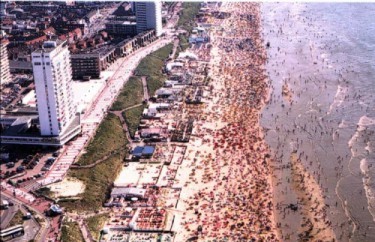|
You are here: /
The Coastal System / User Functions
Subsystem
The User functions represents
one of the two "sub systems" identified in the previous
sections (the other is called Infrastructure)
User functions
The following functions or user categories can be identified:
- basic functions: food production, water supply
and energy supply;
- social functions: housing and recreation;
- economic functions: transport, (sand) mining and
industrial development;
- public functions: defence and sewage treatment.
|

Maximum use of the coast, Zandvoort, Netherlands |
Natural resources
These functions use the natural resources of the
coastal zone. They can be either renewable or non-renewable
resources. Renewable means that the system can regenerate
the resources within a reasonable time interval, e.g.
the recovery of the fish population or the decay of organic
waste. Non-renewable means that the generation of the
resources by the system will not take place within a reasonable
time period, such as the extraction of minerals from the
seabed or the disturbance of the seabed by dredging or
dumping of waste. |
Question

|
|

Space is also a resource, Mamburi, Kenya. |
Types of resources
The resources in the coastal zone includes the compartments
air, water and land. In these compartments four major
categories of resources can be distinguished:
- Space; This includes space for activities of the
users like agriculture, fishing, mariculture, industry,
housing, recreation, etc. Typical criteria to express
the availability of 'space resources' are surface
area, elevation, length and depth (for example navigational
depth);
- Abiotic minerals; This category of resources includes
building materials (for example sand and rock), oil
and gas, ores and water; also air (of a specified
quality) can be incorporated in this category;
- Biotic resources; Flora and fauna used for protein
and carbohydrate supply belong to the class of biotic
resources;
- Absorption or purification capacity; The three compartments
of the coastal resources space represent a certain capacity
to absorb, store, decompose, diffuse and transport waste
materials, emitted as a result of processes in the environment
and (for the major part) activities of the users.
|
Conflicts
The problems in coastal zone management are generally
directed on the resolution of conflicting claims on coastal
and marine resources (common interests). Demands for resources
are often directly related to the activities of the users,
such as space for agricultural activities. But the (subsystem)
Infrastructure will exert important claims on the resources
as well, think of the enclosure of a coastal lagoon from
the sea which may eliminate the nursery function of the
lagoon for sea fish. |
|
|